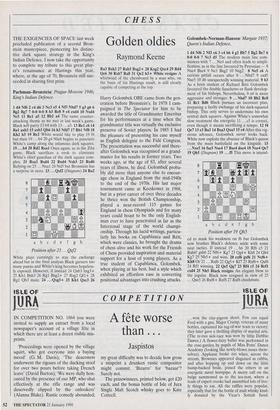CHESS
Golden oldies
Raymond Keene
THE EXIGENCIES OF SPACE last week precluded publication of a second Bron- stein masterpiece, pioneering his distinc- tive dark square strategy in the King's Indian Defence. I now take the opportunity to complete my tribute to this great play- er's renaissance at Hastings this year, where, at the age of 70, Bronstein still suc- ceeded in sharing first prize.
Pachman-Bronstein: Prague-Moscow 1946; King's Indian Defence.
1 d4 Nf6 2 c4 d6 3 Nc3 e5 4 Nf3 Nbd7 5 g3 g6 6 Bg2 Bg7 7 0-0 0.0 8 b3 Re8 9 e4 exd4 10 Nxd4 Nc5 11 Rel a5 12 Bb2 a4 The same counter- attacking theme as we met in last week's game. Black will parry 13 b4 with 13 ... a3. 13 Rel c6 14 Bal axb3 15 axb3 Qb6 16 h3 Nfd7 17 Rbl Nf8 18 Kh2 h5 19 Re2 White would like to play 19 f4 but then 19 ... h4 20 g4 Nfe6 begins to puncture White's camp along the infamous dark squares. 19 ...h4 20 Rd2 Rxal Once again, as in the Zita game, Black sacrifices a rook to eliminate White's chief guardian of the dark square com- plex. 21 Rxal Bxd4 22 Rxd4 Nxb3 23 Rxd6 Relying on 23 ... Nxal 24 Nd5 but Bronstein has a surprise in store. 23 ... Qxf2 (Diagram) 24 Ra2
Position after 23 . . . Qxf2
White plays cunningly to stay the exchange ahead but in the final analysis Black garners too many pawns and White's king becomes hopeless- ly exposed. However, if instead 24 Qxb3 hxg3+ 25 Khl Bxh3 26 Rgl Bxg2+ 27 Rxg2 Qfl + 28 Rgl Qh3 mate. 24 ...Qxg3+ 25 Khl Qxc3 26 Ra3 Bxh3 27 Rxb3 Bxg2+ 28 Kxg2 Qxc4 29 Rd4 Qe6 30 Rxb7 Ra8 31 Qe2 h3+ White resigns A whirlwind of the chessboard by a man who, on the basis of his Hastings result, is still clearly capable of competing at the top.
Harry Golombek OBE came from the gen- eration before Bronstein's. In 1978 I cam- paigned in The Spectator for him to be awarded the title of Grandmaster Emeritus for his performances at a time when the grandmaster title was virtually the exclusive preserve of Soviet players. In 1985 I had the pleasure of presenting his case myself as English delegate to the Fide Congress. The presentation was successful and there- after Golombek was recognised as a grand- master for his results in former years. Two weeks ago, at the age of 83, after several years of illness, he died. GolombeK proba- bly did more than anyone else to encour- age chess in England from the mid-1940s to the end of the 1970s. His last major tournament came at Kecskemet in 1968, but in a prior career of over three decades he thrice won the British Championship, played a near-record 115 games for England in chess Olympiads and for many years could boast to be the only English- man ever to have penetrated as far as the Interzonal stage of the world champi- onship. Through his lucid writings, particu- larly his books on Capablanca and Rai, which were classics, he brought the drama of chess alive and his work for the Friends of Chess provided inspiration and material support for a host of young players. As a true student of Capablanca, Golombek, when playing at his best, had a style which exhibited an effortless ease in converting positional advantages into crushing attacks. Golombek—Norman-Hansen: Margate 1937; Queen's Indian Defence.
1 d4 Nf6 2 Nf3 e6 3 c4 b6 4 g3 Bb7 5 Bg2 Be7 6 0-0 0-0 7 Nc3 d5 The modern main line com- mences with 7 ... Ne4 and often leads to simpli- fication, as in the line favoured by Petrosian — 8 Nxe4 Bxe4 9 Ne 1 Bxg2 10 Nxg2. 8 Ne5 c6 A curious pitfall occurs after 8 ...Nbd7 9 cxd5 NxeS 10 d6 unexpectedly winning material. 9 b3 As a keen student of Richard Red Golombck favoured the double fianchetto or flank develop- ment of his bishops. Nevertheless, 9 e4 is more aggressive and stronger. 9 ...Nbd7 10 Bb2 Rc8 11 Rcl Bd6 Black pursues an incorrect plan, preparing a faulty exchange of his dark-squared bishop. This only serves to undermine his own central dark squares. Against White's somewhat slow treatment the energetic 11 ...c5 is correct, even though it means sacrificing a tempo. 12 f4 Qe7 13 e3 Ba3 14 Bxa3 Qxa3 15 e4 After this vig- orous advance, Golombek never looks back. White now exploits the absence of Black's queen from the main battlefield on the kingside. 15 ...Nxe5 16 fxe5 Nxe4 17 Bxe4 dxe4 18 Nxe4 Qe7 19 Qh5 (Diagram) 19 ...f5 This move is intend-
Position after 19 Qh5
ed to mask his weakness on f6 but Golombek now brushes Black's defence aside with some neat tactics. If instead 19 ... h6 20 Rf6 c5 21 Rxh6! gxh6 22 Nf6+ Kg7 23 Qg4+ Kh8 24 Qh4 Kg7 25 Nh5+ and wins. 20 exf6 gxf6 21 Nxf6+ Kh8 Or 21 ... Racf6 22 Qg5+ Kf7 23 Rxf6+ Qxf6 24 Rfl winning. 22 Qe5 Qg7 23 Rf4 c5 24 Rcfl cxd4 25 Nh5 Black resigns An elegant blow to the jugular. Black now resigned in view of 25 Qxe5 26 RxfS+ Rxf8 27 Rxf8 checkmate.


























































 Previous page
Previous page